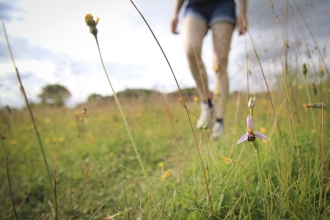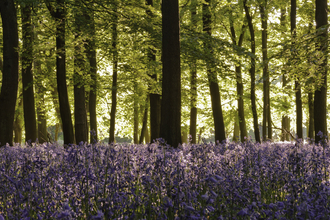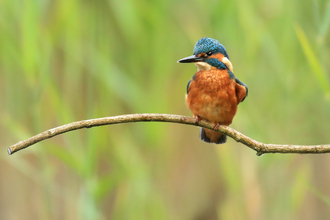

Café at Mere Sands Wood by Charlotte Varela

Woodland at Mere Sands Wood by Charlotte Varela

Great crested grebes by Andrew Parkinson/2020VISION
Mere Sands Wood Nature Reserve
Know before you go
Dogs
Dog bin located in car park
When to visit
Opening times
Car park open 24 hours a day.Visitor centre and cafe: Wednesday - Sunday, 10am - 4pm (open August Bank Holiday Monday 10am - 4pm)
Toilets available in Field Studies Centre: Mondays and Tuesdays, 10am - 3pm.
Best time to visit
July - October for dragonflies, butterflies and the wildflower meadow. Winter for wildfowl.About the reserve
Nestled amongst the peaceful agricultural landscape of Rufford, Mere Sands Wood is a true wildlife haven. Download our map to start exploring.
Did you know... You can enjoy unlimited access to this reserve when you purchase a three, six, or 12-month parking pass. Find out more.
Spring and summer see new life bloom in the form of marsh orchids and broad buckler fern, while the air buzzes with dragonflies and birdsong. Keep your eyes peeled for species like bullfinches, tree sparrows, great spotted woodpeckers, and even sparrow hawks as they fly to and from their nests in the woodland. If you are lucky you may spot the rare willow tit, and if you take a seat in one of the lakeside hides you may even see great crested grebes performing their elaborate courtship ritual.
Autumn and winter mark the arrival of overwintering birds like charming teal, handsome pintail and comical shoveler. Other water birds like little grebes, kingfisher, goosander and bittern have all drawn crowds in recent years, while the lakes and reedbeds also support water rail, reed buntings, goldeneye, pochard, gadwall and more. In all, over 170 bird species have been seen on the reserve, and 60 are known to have bred.
But Mere Sands Wood isn’t just a birder’s paradise – mammal lovers will relish the opportunity to try and spot roe deer, stoats, and foxes as they creep through the broadleaved and conifer woodland. Water voles inhabit the ditches bordering the neighbouring arable land. Bats fly overhead and even red squirrels can be found here. And moth enthusiasts will be delighted by the variety of different species that live here.
A mosaic of habitats including heaths and sandy, wet meadows encourages an impressive array of plants to flourish. Wildflowers like marsh helleborine, golden dock, yellow bartsia and lesser centaury add stunning splashes of colour, while the pink hues of common spotted, early and southern marsh orchids contrast beautifully with buttery yellow-wort. Come autumn the woodlands are bursting with an array of fungi.
Species
Contact us
Environmental designation
Frequently asked questions
Where is the best place to see a specific species on the reserve?
Mere Sands Wood is host to a variety of wild native species – some common and some more rare. Because these species are wild, we cannot guarantee what you may see, or when! If you are trying to spot one of our rarer visitors, we suggest that follow our top tips:
-
Give yourself plenty of time – absorb the peace and tranquillity of the reserve whilst waiting to spot the wildlife
-
Visit at different times of the year – the wildlife and the reserve will change a lot throughout the year
-
Try different times of the day – some wildlife is best spotted around dawn or dusk
-
Use one of our hides – some of our more timid species will be scared by the noise and movement of people and their children or pets. Spending some quiet time in a hide encourages the wildlife to behave more naturally
-
Bring a pair of binoculars with you – some of the wildlife will avoid busy areas but binoculars will help you spot them hiding in places you can’t physically access
-
Please stick to the footpaths – whilst it might be tempting to roam free, this type of exploring damages important habitats
Which hides and viewing platforms can I use?
We have a number of hides and viewing platforms that are available to use. Whilst we aim to keep all areas of the reserve open and accessible at all times, we may need to temporarily close areas due to safety, maintenance or habitat management work. In these instances we will update our website below and post on our social media feeds. If you are unsure on the day of visit you can ask a member of staff in the visitor centre.
Marshall Hide: OPEN – Wheelchair Accessible
Ainscough Hide: OPEN – Wheelchair Accessible
Fletcher Hide: OPEN – Wheelchair Accessible
Redwing Hide: OPEN - Wheelchair Accessible
Rufford Hide: OPEN - Wheelchair Accessible
Mere End Platform: OPEN - Wheelchair Accessible
How do we protect birds at Mere Sands Wood?
The diverse habitats that are present at Mere Sands Wood mean that a variety of wild native bird species choose to forage, nest and breed on site. Our staff and volunteers work hard to manage the health and structure of these habitats which contain a plethora of feeding options for birds. Because natural opportunities are plentiful, we do not need to use bird feeders and we ask visitors not to bring and spread bird food on the reserve.
Allowing birds to forage from the abundance of food available has other benefits too. As well as saving valuable money, this also benefits birds by reducing the risk of avian flu, squirrel pox and rats.
Bird flu – Using bird feeders increases the risk of spreading avian flu through contact with visitors and their clothing.
Squirrel pox - Bird feeding areas attract squirrels and may become a point of contact between grey and red squirrels. Sadly, the Invasive American Grey squirrel carries squirrel pox to the protected Native UK Red squirrel. This contagious disease does not affect grey squirrels but can be deadly to red squirrels. Mere Sands Wood is lucky enough to have populations of Reds visiting the site so removing bird feeding areas is a small way to help protect them.
Rats – Rats are also attracted to food left for birds. In addition to being a health concern to our visitors and staff, rats predate on ground-nesting bird species and raid their nests. We control rats around the visitor centre but are unable to on the wider reserve without the risk of harming other small mammals.
Are dogs allowed in the Visitor Centre and on the reserve?
Dogs are welcome on the reserve but please do keep them under close control and always on a leash. Whilst we love dogs, their presence can cause damage and disturbance to nesting birds, mammals and the habitats they live in. If you are walking with a dog, please make sure you keep to the footpaths and always pick up their waste – we have a dog-waste bin in the car park. Leaving dog waste, either bagged or un-bagged, directly damages the reserve ecology and may result in a fixed penalty fine of up to £100.
Dogs are also allowed in the Visitor Centre, as long as they are kept on the leash and off the furniture.
The government gives some guidance on responsible dog behaviour here: Controlling your dog in public: Overview - GOV.UK (www.gov.uk).
What's on at Mere Sands Wood?
Check out our What's On page for a full list of our upcoming events.
Can I book space at Mere Sands Wood for an event?
Mere Sands Wood has number of spaces available to be booked for business or social use. Please email info@lancswt.org.uk with some details and we will get back to you.
Why has a specific bench been moved?
The reserve has several seating areas and benches which offer a welcome respite and a chance to sit and enjoy the scenery. We regularly check our seating to ensure it is safe and may have to remove seating that has become degraded, or which is too close to an unsafe tree.
Why are trees being felled?
The trees at Mere Sands Wood are of great importance to wildlife for habitat and food, as well as providing an opportunity for visitors to enjoy nature and the environment. In fact, the Lowland mixed deciduous woodland at Mere Sands Wood is so special that it qualifies as a Biodiversity Action Plan habitat: Lowland mixed deciduous woodland (UK BAP Priority Habitat description) (jncc.gov.uk).
One of the defining features of the woodland at Mere Sands Wood is the high percentage of fast growing, colonising tree species such as Silver Birch (Betula spp.), Alder (Alnus glutinosa) and various Willows (Sallix spp.). Over the decades, a number of areas of open ground have developed into Secondary woodland through the natural processes of ecological succession (Ecological succession - Wikipedia). However, without the intervention of wild animals such as deer, cows and beavers, the woodland has developed in a different – and unsustainable way. Although it appears healthy, the current woodland is mostly of a similar age, species mix and density which, if left undisturbed, drastically reduces habitat diversity.
One of the main ways the LWT is able to influence and improve the structure of our woodlands is through the selective thinning of certain trees. This makes room for new growth to fill gaps in the understory and can also be used to benefit mature trees, such as our older Oaks (Quercus robur) by giving them space to grow without pressure from faster species. There are also occasions where we will clear small blocks of woodland to make glades and then allow the area to regenerate naturally which given time will become canopy woodland once more. This reintroduction of a stratified woodland structure is key to improving the health and diversity of our woodlands and is common practice for good conservation woodland management.
In addition to the natural woodland communities present on site there are a few ‘working woodland’ habitats. These being the coppice woodland and pine plantation.
Coppice woodland
Coppicing is a traditional management practice that dates back to prehistoric times and continues to this day around the world. Coppicing is where resilient, fast growing, shade tolerant tree species are planted, grown, harvested and allowed to regrow. At Mere Sands Wood we coppice Hazel, Sycamore and Silver birch as this promotes woodland health and increases the variety of food and habitat for a wide range of insects and animals. The resulting wood is used for our conservation work and sometimes sold in our shop.
Pine plantation
The centre of the reserve is noticeably different from the rest of the woodland due to it being dominated by tall mature pine trees, mostly Scots Pine (Pinus sylvestris). These trees were planted by previous landowners to produce timber with the aim of them being managed and felled to produce income and materials. Currently the pines create a close, shaded canopy which limits the growth of other trees in the lower levels of the woodland. Selectively thinning the pine over a number of years creates gaps to allow mixed native broadleaved tree species to return, diversifying the age, species and structure of the area. This holds numerous benefits for wildlife and, as it is managed over several decades, will not impact the overall cover of woodland in the area.
This allows us to produce sustainably sourced timber for our conservation projects. For example, our timber has been used for fencing and cladding across our reserves, reducing the expense and carbon footprint of purchasing new materials.
Tree Safety Management
Falling trees and branches can offer a significant risk to the safety of our staff, volunteers and visitors and cause damage to buildings, property and vehicles. The Trust has a legal duty of care to manage these safety risks, as set out in the Health and Safety at Work Act and the Occupier’s Liability Act. For this reason, trees that may pose a risk are assessed and action taken where appropriate. We aim to retain trees where possible and we may prefer to temporarily limit access to an area of risk or move seating away from highlighted risk areas.
Forestry Commission
All the woodland work we do is part of our 10-year woodland management plan, which is reviewed and adjusted regularly to make sure it benefits nature and our visitors. This plan has been approved by the Forestry Commission who, in the UK, regulate the management of woodlands on behalf of the government.

Mere Sands Wood by Jason Lock
Volunteer in our Welcome Centre
We need volunteers to take care of our visitors and help raise vital income for Mere Sands Wood in our Welcome Centre, shop, café, kitchen and office. We're also in need of Maintenance Volunteers.
Can you help our visitors finish their day out with wonderful memories and a smile on their face?



